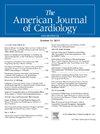评估冠状动脉反应性测试中静脉注射腺苷与冠状动脉内注射腺苷的效果。
IF 2.3
3区 医学
Q2 CARDIAC & CARDIOVASCULAR SYSTEMS
引用次数: 0
摘要
背景:通过冠状动脉栓塞热稀释获得的冠状动脉血流储备(CFR)和微循环阻力指数(IMR)用于评估和治疗心绞痛和无阻塞性冠状动脉疾病(ANOCA)患者。之前的研究表明,使用静脉注射(IV)或冠状动脉内(IC)腺苷通过分数血流储备评估心外膜缺血的结果具有可比性。目前尚不清楚在进行冠状动脉反应性测试(CRT)时,使用腺苷进行 IC 和 IV 充血是否具有相似性:我们回顾了一组因 INOCA 而接受 CRT 的患者的 CRT 数据和基线人口统计学特征。我们使用线性回归、单因素方差分析、Wilcoxon 和 Bland-Altman 分析评估了通过 IC 和 IV 方法获得最大充血的患者的 CFR 和 IMR:我们评估了 62 名患者,中位年龄为 60.5 岁(50,67),72% 为女性。使用 IC 腺苷的平均 CFR 为 3.12(2.31,4.06),使用 IV 腺苷的平均 CFR 为 2.71(2.0,3.88),R2 值为 0.50(p2 值为 0.33):因此,在使用栓剂热稀释的 CRT 中,使用 IC 腺苷获得的 CFR 和 IMR 值与使用静脉注射腺苷获得的值有很好的相关性。这为栓塞热稀释 CRT 测试提供了一种替代静脉注射腺苷的潜在方法。本文章由计算机程序翻译,如有差异,请以英文原文为准。
Evaluation of Intravenous Versus Intracoronary Adenosine in Coronary Reactivity Testing
Coronary flow reserve (CFR) and index of microcirculatory resistance (IMR) obtained through coronary bolus thermodilution are used to assess and treat patients with angina and no obstructive coronary artery disease. Previous studies demonstrate comparable results assessing epicardial ischemia by fractional flow reserve using intravenous (IV) or intracoronary (IC) adenosine. It is unknown if there is a similarity between IC and IV hyperemia with adenosine when performing coronary reactivity testing (CRT). We reviewed CRT data and baseline demographics in a cohort of patients who underwent CRT for ischemia and no obstructive coronary artery disease. We evaluated CFR and IMR in patients whereby maximal hyperemia was obtained by both IC and IV means using linear regression, one-way analysis of variance, Wilcoxon, and Bland-Altman analysis. We assessed 62 patients with a median age of 60.5 years (50 to 67), and 72% were females. The average CFR with IC adenosine was 3.12 (2.31 to 4.06) and 2.71 (2.0 to 3.88) with IV adenosine, with an R2 value of 0.50 (p <0.0001). The average IMR with IC adenosine was 28.23 (16.24 to 50.72) and 22.27 (14.79 to 37.0) with IV adenosine, with an R2 value of 0.33 (p <0.0001). Average intra-method variability between IC and IV adenosine was nonsignificant (p = 0.31 for CFR and p = 0.55 for IMR). Bland-Altman analysis showed reasonable agreement between IV and IC adenosine for CFR and IMR with slightly higher values using IC adenosine. Therefore, in CRT with bolus thermodilution, CFR and IMR values obtained with IC adenosine correlate well with those obtained with IV adenosine. This presents a potential alternative to IV adenosine for bolus thermodilution CRT.
求助全文
通过发布文献求助,成功后即可免费获取论文全文。
去求助
来源期刊

American Journal of Cardiology
医学-心血管系统
CiteScore
4.00
自引率
3.60%
发文量
698
审稿时长
33 days
期刊介绍:
Published 24 times a year, The American Journal of Cardiology® is an independent journal designed for cardiovascular disease specialists and internists with a subspecialty in cardiology throughout the world. AJC is an independent, scientific, peer-reviewed journal of original articles that focus on the practical, clinical approach to the diagnosis and treatment of cardiovascular disease. AJC has one of the fastest acceptance to publication times in Cardiology. Features report on systemic hypertension, methodology, drugs, pacing, arrhythmia, preventive cardiology, congestive heart failure, valvular heart disease, congenital heart disease, and cardiomyopathy. Also included are editorials, readers'' comments, and symposia.
 求助内容:
求助内容: 应助结果提醒方式:
应助结果提醒方式:


